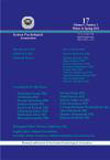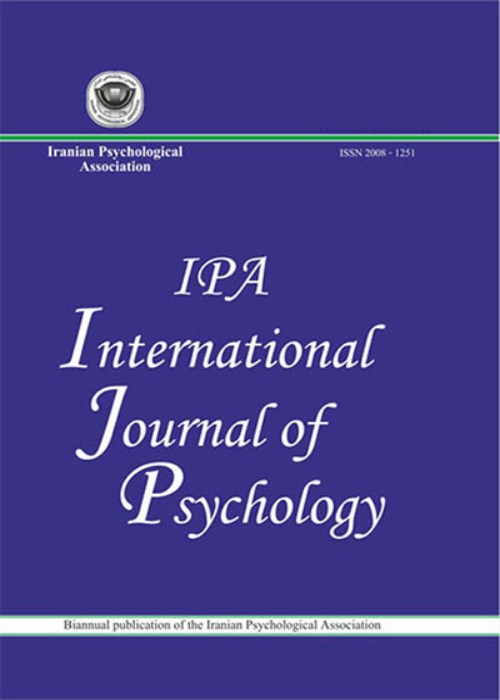فهرست مطالب

International Journal of Psychology
Volume:9 Issue: 2, Summer-Fall 2015
- تاریخ انتشار: 1394/07/09
- تعداد عناوین: 7
-
-
Page 1The present study aimed toinvestigate the effectiveness of problem solving skills training on academic help-seeking and self-efficacy of students. The population consisted of high school female students during the academic year of 2011/2012 in Ghaemshahr, Iran.The sample consisted of 50 female students selected through multistage clusteringand they were divided into control and experimental groups (25 students in each group). Research tools included help-seeking behavior questionnaire and general self-efficacy scale (GSES). Problem solvingskills training duringeight sessions (2 hours) was appliedfor one month. Data was analyzed using descriptive statistics and multivariate analysis of covariance (MANCOVA). Results showed that problem solving skillstraining influenced adaptive help-seeking, avoidance of help-seeking and self-efficacy of students, so that it increased adaptive help-seeking, reduced avoidance of help-seeking and increased self-efficacy of the experimental group compared to the control group. The results of this study have important implications in the field of improved performance and academic achievement of students.Keywords: Problem solving skills training, adaptive help, seeking, avoidance of help, seeking, self, efficacy
-
Page 25This study examines the relationships among sociocultural attitudes toward appearance, perfect physical appearance, appearance investment and the tendency forcosmetic surgery. Data wascollectedfrom 631 students (male and female), aged between 18 and 49 years (M=21.83, SD=4.09). Results indicated that all of the predictors examined correlated with positive attitudes toward cosmetic surgery. Furthermore, worry about imperfection as one of perfectphysical appearance subscales moderated the relation between sociocultural attitudes toward appearance and appearance investment. Likewise, sociocultural attitudes toward appearance had a direct and indirect effect (via appearance investment) on the tendency forcosmetic surgery. That is, appearance investment partially mediated the association between media influences and attitudes toward cosmetic surgery. These findings suggest that a greater perfectionist tendency and a greater psychological investment in physical appearance among mass media messages about beauty predict more favorable attitudes toward cosmetic surgery.Keywords: appearance investment, cosmetic surgery, media influences, perfectionism
-
Application of Fuzzy System in Psychological Tests: Optimize the Number of Questions for WHOQOL-BREFPage 51The WHOQOL-BREF is one of the best known questionnaires for measuring the quality of life. It is currently available in more than 40 languages and has been used frequently in cross-cultural comparison studies on subjective well-being and quality of life studies. Some research shows that due to certaincultural biases Iranian respondentshave no tendency or willingness to responding some questions, more specially, question 21, in WHOQOL-BREF. The main aim of the current research was to use the ability and flexibility of fuzzy systems to analyse the WHOQOL-BREF questions to reduce some unclear or doubtful questions. A fuzzy system model proposes to diminish the errors that produce ambiguous concepts by not responding to certain biased questions.TheWHOQOL-BREEquestionnaire was analyzed and both the traditional model and the fuzzy model analyses were compared for results using fuzzy systems.As a result, question 21 was removed from the WHOQOL-BREF questionnaire used by the fuzzy system.Keywords: WHOQOL, BREF, psychological test, fuzzy system, Wang, Mandel method, Quality Of Life, Cultural Bias
-
Page 76The main purpose of this study was to examine the relationships between the big five personality traits and happiness with religious orientation as a mediator. The participants consisted of 301 Shiraz University students (110 males and 191 females) selected by applying a multistage random sampling method. Participants completed three questionnaires: NEO-FFI or the short personality inventory of Costa and Mc Crae (1992); the Intrinsic-Extrinsic Religious Orientation Scale (IEROS, Allport & Ross, 1967); and the Oxford Happiness Inventory (OHI) (Argyle, 1989). These instruments showed appropriate reliability and validity. Multiple regression and path analysis were the major statistical analyses run in the study. Results of multiple regressions revealed that extraversion, and intrinsic religious orientations were the positive predictors of happiness, in contrast to Neuroticism which predicted happiness negatively. Also, results showed that religion orientation played the mediation role between these relationships. The findings indicated that this model is a proper model to explain the mechanism of the effects of personality traits on happiness. Based on the findings, to increase the level of happiness in neurotic people it would seem useful to intervene by increasing the intrinsic religious orientation.Keywords: the big five personality traits, religious orientation, happiness, students
-
Page 94The present study aims to examine the relationship between personality characteristics, social factors, and identity styles in adolescents. A correlational method was employed. Statistical population in this research consists of all high-school and pre-university students living in Golestanprovince during the year this research was being conducted.The sample included students (n=380) aged 17 and 18.In this study, the stratifiedrandom sampling method was used.Data were collected through self-administered questionnaires (identity styles, including: informational identity style, normative identity style, diffuse/avoidance style, commitment and social factors, including: family relationship, school and peer group relationship and personality characteristics, including: agreeableness, neuroticism, extraversion, conscientiousness and openness to experience.Descriptive and inferential statistics such as Mean, Standard Division, and Pearson correlation were used. The findings showed that there were significant correlations between personality characteristics and identity styles in adolescents. Significant correlations between social factors and identity styles in adolescents were also observed. In addition according to the results, a moderate and positive correlation was observed between informational and normative styles, informational style and commitment, normative style and commitment, as well as commitment and neuroticism. Additionaly, the results of the study supported theories like social cognitive theory, General other theory, and triat approach. The results shed new light on the processes involved in the personality characteristics and social factors of adolescents’ styles of identity exploration.Keywords: personality characteristics, social factors, identity styles
-
Page 125
The present study tested a conceptual model of the relationships among religious well-being، existential well-being، positive religious coping، and family protective factors. A sample of three hundred and eighty nine voluntary and unpaid Muslim participants (230 females، 159 males)، aged between 21 and 47 years old (31. 18 ± 4. 28 years)، were selected through multi-stage cluster sampling in Isfahan، Iran. All participants were asked to complete the Spiritual Well-Being Scale (SWBS; Paloutzian & Ellison، 1982)، the Brief Religious Coping Scale (RCOPE; Pargament، Smith، Koenig، & Perez، 1998)، and the Inventory of Family Protective Factors (IFPF; Gardner، Huber، Steiner، Vasquez & Savage، 2008). Using structural equation modeling، the results supported the mediating effects for existential well-being and positive religious coping among religious well-being and family protective factors. The analytic model explained 40% of the distribution of family protective factors. These findings suggest that the positive impact of religious well-being is correlated with family protective factors.
Keywords: religious well, being, existential well, positive religious coping, family protective factors -
Page 148The present study aimed at investigating the impact of proactive personality, conscientiousness, and perceived supervisor support on job satisfaction and performance mediated by proactive behavior. The statistical population of this survey consisted of the official staff and contractual personnel of Bid Boland gas refinery from whom 260 people were selected using hierarchical random sampling method. The data collection tools were Proactive Personality Scale (Batman and Crant, 1993), NEO Personality Inventory (Conscientiousness dimension), Perceived Supervisor Support Scale (Kottke & Sharafiniski, 1998), Proactive Behavior Questionnaire (Ashford and Black, 1996), Job Satisfaction Questionnaire (Brayfield & Rothe, 1951) and Job Performance Questionnaire (Paterson, 1992). The assessment of the proposed pattern was conducted through path analysis. The results supported the suitability of the relationship between the patterns and the collected data. Significant and better relationship could be achieved by eliminating two insignificant paths and coordinating their errors. The results revealed that proactive behavior mediated theeffect of proactive personality and perceived supervisor support on job satisfaction and performance.Keywords: proactive personality, conscientiousness, perceived supervisor support, job satisfaction, performance, proactive behavior


